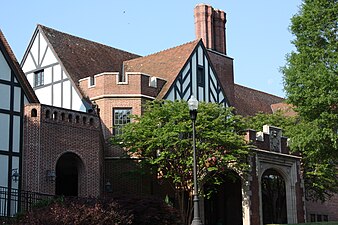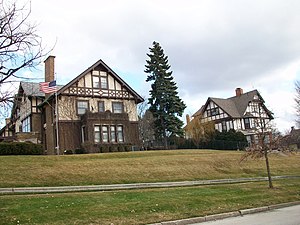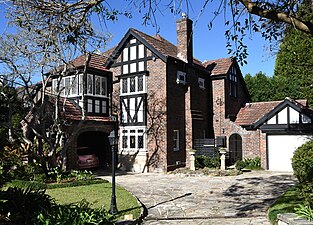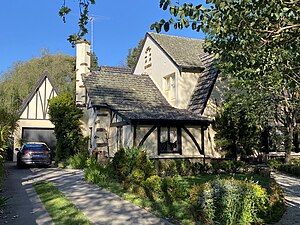Tudor Revival architecture
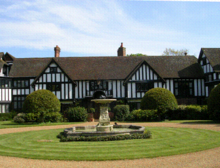
Tudor Revival architecture, also known as mock Tudor in the UK, first manifested in domestic architecture in the United Kingdom in the latter half of the 19th century. Based on revival of aspects that were perceived as Tudor architecture, in reality it usually took the style of English vernacular architecture of the Middle Ages that had survived into the Tudor period.[1]
The style later became an influence elsewhere, especially the British colonies. For example, in
Tudorbethan is a subset of Tudor Revival architecture that eliminated some of the more complex aspects of Jacobethan in favour of more domestic styles of "Merrie England", which were cosier and quaint. It was associated with the Arts and Crafts movement.
Identification
Today, the term '
When the style was revived, the emphasis was typically on the simple, rustic, and the less impressive aspects of Tudor architecture, imitating in this way medieval houses and rural cottages. Although the style follows these more modest characteristics, items such as steeply
History
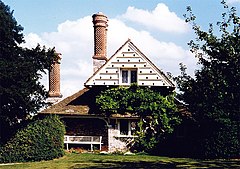
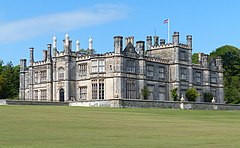
Although the Gothic style remained popular in Britain well into the
As the last and most recent phase of the Gothic period, the Tudor style had the most secular survivals in 17th and 18th-century England; many older buildings were rebuilt, added to, or redecorated with ornament in the Tudor period. As such, the Tudor style had perhaps an over-sized influence on the image formed by the
In the group of nine cottages at
Examples of the Tudor or
20th century
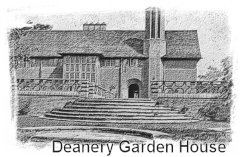
In the early part of the 20th century, one of the exponents who developed the style further was Edwin Lutyens (1864–1944). At The Deanery in Berkshire, 1899, (right), where the client was the editor of the influential magazine Country Life,[18] details like the openwork brick balustrade, the many-paned oriel window and facetted staircase tower, the shadowed windows under the eaves, or the prominent clustered chimneys were conventional Tudor Revival borrowings, some of which Lutyens was to remake in his own style, that already predominates in the dark recessed entryway, the confident massing, and his signature semi-circular terrace steps. This is Tudorbethan at its best, free in ground plan, stripped of cuteness, yet warmly vernacular in effect, familiar though new, eminently liveable. The Deanery was another example of the "naturalistic" approach; an anonymous reviewer for Country Life in 1903 wrote; "So naturally has the house been planned that it seems to have grown out of the landscape rather than to have been fitted into it".[19] An example of Tudorbethan architecture was that seen at Greaves Hall, which was built in 1900 as a mansion house for the Scarisbrick family. Many of the features of the original building could still be seen until it was demolished in 2009.[20]
Later came
Following the First World War many London outer suburbs had developments of houses in the style, all reflecting the taste for nostalgia for rural values.[25] In the first half of the 20th century, increasingly minimal "Tudor" references for "instant" atmosphere in speculative construction cheapened the style. The writer Olive Cook had this debased approach firmly in her sights when she attacked, "the rash of semi-detached villas, bedizened with Tudor gables, mock half-timber work, rough cast and bay windows of every shape which disfigures the outskirts of all our towns".[25] It was also copied in many areas of the world, including the United States and Canada. New York City suburbs such as Westchester County, New York and Englewood and Teaneck, New Jersey feature particularly dense concentrations of Tudor Revival construction from this period.[26]
Brewery companies designed "improved" pubs, some in a mock Tudor style called Brewer's Tudor.[27] The style was captured in John Betjeman's 1937 poem Slough, where "bald young clerks" gather:
And talk of sport and makes of cars
In various bogus-Tudor bars
And daren't look up and see the stars.[28]
The late 20th century has seen a change in the faithfulness of emulation of the style, since in a modern development it is common to have only a few basic floor plans for buildings, these combined with variations in interior surface treatment and in the exterior in rooflines and setbacks to provide a visual variety to the street view. Owing to the smaller lots employed in modern developments (especially in the
21st century

Many British builders include variations on Tudorbethan in the range of styles they draw on, and the style tends to be associated with
In modern structures, usually on estates of private houses, a half-timbered appearance is obtained by applied decorative features over the "real" structure, typically wood stud framing or concrete block masonry. A combination of boards and
Evolution

The Tudor Revival style was a reaction to the ornate
The Tudor style made one of its first appearances in Britain in the late 1860s at
At approximately the same time, Shaw also designed Leyswood near Withyham in East Sussex,[37] which was a large mansion around a courtyard, complete with mock battlements, towers, half-timbered upper facades and tall chimneys – all features quite readily associated with Tudor architecture; in Shaw's hands, this less fantastical style achieved immediate maturity.[38] Confusingly, it was then promptly named "Queen Anne style", when in reality it combined a revival of Elizabethan and Jacobean design details including mullioned and oriel windows. The style later began to incorporate the classic pre-Georgian features that are generally understood to represent "Queen Anne" in Britain. The term "Queen Anne" for this style of architecture is now only commonly used in the USA. While in Britain the style remained closer to its Tudor roots, in the USA it evolved into a form of architecture not instantly recognisable as that constructed in either the Tudor or Queen Anne period.[39]
The style was also utilised for public buildings; an early example was the Great Hall and Library at Lincoln's Inn in central London, built in the late 1840s.[40][41] The architect was Philip Hardwick, better known for the classical Euston Arch.[42] The historian Michael Hall considers the hall and library among "the finest Tudor Revival buildings (of) the nineteenth century.[43]
Tudorbethan
Tudorbethan represents a subset of Tudor Revival architecture; the word is modelled on
Half-timbering



From the 1880s onward, Tudor Revival concentrated more on the simple but quaintly
Tudor Revival houses are dissimilar to the
Some more enlightened landlords at this time became more aware of the needs for proper sanitation and housing for their employees, and some
A very well-known example of the idealised half-timbered style is Liberty & Co. department store in London, which was built in the style of a vast half-timbered Tudor mansion. The store specialised, among other goods, in fabrics and furnishings by the leading designers of the Arts and Crafts movement.[d][53]
Interiors
The interiors of the Tudor style building have evolved considerably along with the style, often becoming truer to the replicated era than were the first examples of the revival style, where the style "rarely went far indoors".
In some of the larger Tudor style houses the Tudor great hall would be suggested by the reception hall, often furnished as a sitting or dining room. Large wooden staircases of several flights were often prominently positioned, based on Jacobean prototypes. It is this mingling of styles that has led to the term Jacobethan which resulted in houses such as Harlaxton Manor which bore little if any resemblance to a building from either period. Hall notes the influence of Burghley House and Wollaton Hall, "fused with ideas drawn from Continental architecture of the seventeenth and eighteenth centuries".[62]
More often it is in the Tudor style houses of the very early 20th century that a greater devotion to the Tudor period is found, with appropriate interior layout, albeit coupled with modern-day comforts. This can be seen in older upscale neighbourhoods where the lots are sufficiently large to allow the house to have an individual presence, despite variations in the style of neighboring houses. Whether of older or recent origin, the appearance of solid beams and half-timbered exterior walls is only superficial. Artificially aged and blackened beams are constructed from light wood, bear no loads, and are attached to ceilings and walls purely for decoration, while artificial flames leap from wrought iron fire-dogs in an inglenook often a third of the size of the room in which they are situated. Occasionally, owners sought to replicate more closely the conditions of Tudor living; an example were
Gallery
Europe
-
Cecilienhof in Potsdam, Germany 1913–1917
-
Petwood Hotel, Woodall Spa, England (1905)
-
Bray Town Hall, Bray, County Wicklow, Ireland
North America
-
Philip Shutzein 1923
-
Edward C. Cressett House (left) and the Parke T. Burrows House in Davenport, Iowa
-
Westover Manor in Westover Hills, Texas in 2014
-
Downtown Suffern, New York in 2011
Australia and New Zealand
-
House in Mosman, New South Wales
-
House inKillara, New South Wales
-
Tudor Revival house in Unley Park, South Australia
-
House inAdelaide, South Australia
Explanatory footnotes
- ^ Wren consciously set out to imitate Cardinal Wolsey's architectural style. Writing to Dean Fell in 1681, he noted; "I resolved it ought to be Gothic to agree with the Founder's work", adding that to do otherwise would lead to "an unhandsome medley". Pevsner suggests that he succeeded "to the extent that innocent visitors never notice the difference".[7]
- ^ Nash also undertook the design of a number of larger mansions in the Tudor style, of which Longner Hall in Shropshire is the only surviving example.[11]
- ^ Pevsner describes Wilkins' Dalmeny as "the finest of his houses in (the Tudor Gothic) style". The Roseberys originally lived at Barnbougle Castle, directly on the shoreline of the Firth of Forth. They built Dalmeny further inland, reputedly after the third earl was "drenched by a huge wave" while at dinner.[13]
- ^ Pevsner records that the timbers used on Liberty's Great Marlborough Street frontage were the "real article (sourced) from genuine men-of-war, the Hindustan and the Impregnable" and that, unusually for Tudor Revival buildings, they were "pegged and mortised, not just stuck on".[53]
- Dawpool Hall on the Wirral.[56] One of these now forms the porch of The Pantheon at Portmeirion[57] and the other went unsold on eBay in 2012.[58] Shaw's biographer, Andrew Saint writes, "inglenooks are the decorative pièce de résistance of the Shaw country house".[59]
Citations
- ^ "Tudor Revival". Oxford Reference. Retrieved 2024-01-18.
- ^ Airs 1995, Introduction.
- ^ Summerson, Chapter 1 to 4 cover this period; this brief summary is rather over-simplified.
- ^ Airs 1995, Foreword.
- ^ Summerson, 23
- ^ Curl 1990, p. 83.
- ^ Sherwood & Pevsner 2002, pp. 110–111.
- ^ Summerson, 235-236
- ^ Summerson, 366-376, 447-452
- ^ Davis 1960, p. 72.
- ^ Davis 1960, p. 28.
- ^ Aslet and Power, 151-152; Summerson, 451
- ^ McWilliam 1978, pp. 170–172.
- ^ Historic Environment Scotland. "Dalmeny House, including Terrace, Garden Walls, Railings, Gates and Gatepiers (Category A Listed Building) (LB82)". Retrieved 14 July 2019.
- ^ Aslet and Power, 152-153 (153 quoted), 158-159, 162
- ^ Aslet and Power, 162-163
- ^ "Saitta House – Report Part 1 Archived 2008-12-16 at the Wayback Machine",DykerHeightsCivicAssociation.com
- ^ Hussey 1989, p. 95.
- ^ Hall 1994, p. 178.
- ^ Bona-SOU, Emilia (July 6, 2016). "133 homes planned for former Greaves Hall site". southportvisiter.
- ^ Aslet & Powers 1985, p. 248.
- ^ a b Nairn, Pevsner & Cherry 1971, p. 177.
- ^ Tinniswood 2016, pp. 62–64.
- ^ Tinniswood 2016, p. 63.
- ^ a b Cook 1984, p. 307.
- ^ "5 Sweet Southern Westchester Neighborhoods To Explore". Westchester Magazine. 21 January 2015. Retrieved December 22, 2018.
- ^ "Brewery History: 119, pp. 2-9". www.breweryhistory.com.
- ^ "Slough - John Betjeman". www-cdr.stanford.edu.
- ^ Quiney 1990, p. 214.
- ^ Ryan 2018, p. 146.
- ^ "Tudor Style Homes with Faux Planks". Faux Wood Workshop.
- ^ "What is Tudor Revival style?- Elizabethan - Tudorbethan - Mock Tudor - Architecture". www.antiquehomestyle.com.
- ^ Dean, p250-251
- ^ Saint 2010, p. 80.
- ^ a b Pevsner & Richmond 2002, p. 244.
- ^ Girouard 1979, p. 312.
- ^ Turnor 1950, p. 101.
- ^ Aslet and Power, 162-164
- ^ "Queen Anne". Architecture Styles of America and Europe. October 17, 2011.
- ^ Historic England. "New Hall (Grade II*) (1379298)". National Heritage List for England. Retrieved 3 July 2019.
- ^ Historic England. "New Hall Library (Grade II*) (1379299)". National Heritage List for England. Retrieved 3 July 2019.
- ^ Physick & Darby 1973, p. 153.
- ^ Hall 2009, p. 98.
- ^ "Modern era buildings: a spotters' guide". The Guardian. September 10, 2011 – via www.theguardian.com.
- ^ Robinson, P8
- ^ Jenkins 2003, p. 21.
- ^ Davey 1995, p. 90.
- ^ Allibone 1991, p. 101.
- ^ Pevsner & Williamson 2003, p. 475.
- ^ Curl 1990, p. 80.
- ^ Aslet 2013, p. 53.
- ^ de Moubray 2013, p. 50.
- ^ a b Bradley & Pevsner 2003, p. 456.
- ^ Aslet and Power, 248
- ^ Saint 2010, p. 45.
- ^ Saint 2010, p. 290.
- ^ "The Pantheon, Portmeirion". www.coflein.gov.uk. RCAHMW. Retrieved 18 September 2018.
- ^ Wainwright, Martin (19 January 2012). "Titanic owner's massive white elephant lumbers on to eBay". The Guardian. Retrieved 18 September 2018.
- ^ Saint 2010, p. 137.
- ^ Robinson, p9
- ^ Hall 2009, p. 164.
- ^ Hall 2009, p. 26.
- ^ Aslet 1982, p. 173.
- ^ Aslet 1982, p. 179.
- ^ Aslet 1982, p. 174.
General and cited references
- OCLC 963827785.
- OCLC 231443025.
- ISBN 978-0-30003-4745.
- OCLC 840477309.
- ISBN 0670801755.
- Bradley, Simon; ISBN 978-0-300-09595-1.
- ISBN 978-0-14006-7385.
- OCLC 823781473.
- Davey, Peter (1995). Arts and Crafts Architecture. London: ISBN 978-07148-2874-9.
- Davis, Terence (1960). The Architecture of John Nash. London: Longacre Press Ltd. OCLC 559524050.
- ISBN 9781905400492
- ISBN 978-0-30002-3909.
- Hall, Michael (1994). The English Country House: From the Archives of Country Life 1897–1939. London: OCLC 832426788.
- Hall, Michael (2009). The Victorian Country House. London, UK: ISBN 978-1-84513-4570.
- ISBN 978-0-90746-2590.
- ISBN 978-0-71399-5961.
- de Moubray, Amicia (2013). Twentieth Century Castles In Britain. London, UK: ISBN 978-0-71123-1788.
- McWilliam, Colin (1978). Lothian. The Buildings of Scotland. Harmondsworth, UK: OCLC 669710509.
- ISBN 0-300-09675-5.
- ISBN 978-0-30009-6385.
- OCLC 835201226.
- Physick, John; Darby, Michael (1973). Marble Halls - Drawings and Models of Victorian Secular Buildings. Margate, Kent: Eyre and Spottiswoode Ltd. ISBN 978-0-90148-6684.
- OCLC 473283902.
- Robinson, John Martin, Ascott, 2008, Scala Publishers Ltd, ISBN 1857595041
- Ryan, Deborah Sugg (2018). Ideal homes, 1918-39: Domestic design and suburban modernism. Manchester, UK: ISBN 978-0-71906-8850.
- ISBN 978-0-30015-5266.
- Sherwood, Jennifer; ISBN 978-0-30009-6392.
- ISBN 0140560033
- Turnor, Reginald (1950). Nineteenth Century Architecture in Britain. London, UK: OCLC 520344.
- Tinniswood, Adrian (2016). The Long Weekend: Life in the English Country House Between the Wars. London: OCLC 951261677.





